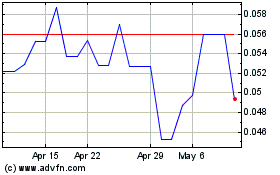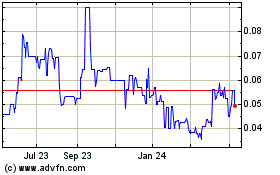
Is Tin the New Energy Metal?
Toronto, Ontario -- April 10, 2018 -- InvestorsHub NewsWire --
BacTech Environmental Corporation (“BacTech or the Company”) –
CSE: BAC, OTC: BCCEF
At a recent Lithium and Battery Material conference held in
Perth, Australia the head of Rio Tinto’s Venture (“RTZ”) group
presented a chart from a Massachusetts Institute of Technology
(“MIT”) study they had commissioned to determine what metals and
minerals were to be most impacted by new technologies using a
number of criteria. Surprisingly, tin ranked #1 in the MIT study
(see chart). The question is what was the reason behind their
choice to rank tin #1?

It seems that every day there is a new technology that changes
the demand landscape for existing materials. Lithium, of course, is
the most recent and best example of a new use for an old material
that has driven the price of it much higher due to increased
demand. In markets where supply is constrained the effect on prices
is even more exacerbated. This argument can be made for tin as
prices in the early months of 2018 have risen to over $21,000 per
tonne. There is a steady, rising trend of tin use in electronics
and new strong indications that it will be used in emerging
technologies coupled with a static supply curve has led to
strengthening prices.
Tin is expected to increasingly contribute to modern, clean
technologies including lithium-ion batteries for autonomous and
electric vehicles. What is shaping up to be the wildcard is
the battery market where advances have been made in battery
technology. For instance, tin is used as a component in improving
the productivity of lead-acid batteries. In 2016, China consumed
12,000 metric tonnes of tin for this application and globally
26,000 metric tonnes are consumed annually, and this number is
rising making it the 4th most significant application
for tin globally. To put this in context, the annual global mine
supply of tin in 2017 was 280,000 tonnes.
Also, battery researchers are developing solid-state batteries
utilising ceramic electrolytes (versus liquid) for improved safety
and performance. Recent research has shown that adding tin to the
silicon-based anode enhances its performance, creating the
potential for tin to be a significant contributor to the next
generation of lithium batteries.
As noted by Avalon Advanced Materials Inc. in their Industry
Bulletin dated March 27, 2018, researchers at the Texas Material
Institute have demonstrated a tin-aluminium alloy can be produced
that is cheaper and double the charge capacity of today’s
copper-graphite anodes for lithium-ion batteries.
Based on information from an independent NI 43-101 resource
calculation completed in 2017, tin values account for 50% of the
contained metal in BacTech’s Telamayu Tailings Project in
Bolivia.
BacTech is optimizing its processing methods on the material at
Telamayu to unlock the maximum amount of metal for recovery, which
is anticipated to include not only tin but silver and copper.
BacTech has been advised by the University of Oruro in Bolivia,
which is an accredited lab, that our latest results which will
detail metal recovery to date will be available for dissemination
in the near future. Work is underway to add to our tin tailings
holdings in Bolivia, a country that historically been one of the
largest tin producers in the world.
Ross Orr, BacTech’s President and CEO stated “Given the limited
number of public tin producers, BacTech, with its established tin
resources, has the potential to become a near term tin producer.
Based on the advanced stage of our Telamayu Tailings Project we
have the capability to be in production in months, not years.”
Project Overview
The Telamayu project involves the environmental remediation of
the “Antiguo” tailings and a Company option on the larger “Nuevo”
tailings, both situated at the Telamayu mill site near the town of
Atocha in the Department of Potosi in Bolivia. As part of the
remediation process BacTech will recover silver, tin, and copper
utilizing a conventional processing technology.
The existing Telamayu mill concentrator has generated the
Antiguo and Nuevo tailings by processing mineralized material from
the surrounding mines for over 80 years. There is considerable
infrastructure at the mill site including high voltage power, rail,
mill housing, and a local workforce. The current infrastructure
will contribute to a reduction in capital costs of the project.
Currently metallurgical test work is underway to determine the
percentage of metal to be recoverable.
In addition, bioleach test work on concentrates and tailings
material from the Ponce Enriques area of southern Ecuador continues
at Laurentian University in Sudbury, Canada.
For further information contact: Ross Orr, President & CEO
BacTech Environmental Corporation/ 416-813-0303 ext. 222 Email:
borr@bactechgreen.com
Lalli Marrato, Investor Relations: 647-669-7646, Email: lalli@frontiermcg.com
Robin Cook, Investor Relations: 416-809-1738, Email: robin@frontiermcg.com
Follow us on:
Facebook http://www.facebook.com/BacTechGreen
Twitter-http://twitter.com/BacTechGreen
LinkedIn http://www.linkedin.com/company/1613873
Vimeo http://vimeo.com/bactechgreen
YouTube http://www.youtube.com/user/bactechgreen
Special Note Regarding Forward-Looking Statements
This news release contains “forward-looking information”, which may
include, but is not limited to, statements with respect to future
tailings sites, sampling or other investigations of tailing sites,
the Company’s ability to make use of infrastructure around tailings
sites or operating performance of the Company and its projects.
Often, but not always, forward-looking statements can be identified
using words such as “plans”, “expects”, “is expected”, “budget”,
“scheduled”, “estimates”, “forecasts”, “intends”, “anticipates”, or
believes” or variations (including negative variations) of such
words and phrases, or state that certain actions, events or results
“may”, “could”, “would”, “might” or “will” be taken, occur or be
achieved. Forward-looking statements involve known and unknown
risks, uncertainties and other factors which may cause the actual
results, performance or achievements of the Company to be
materially different from any future results, performance or
achievements expressed or implied by the forward-looking
statements. Forward-looking statements contained herein are made as
of the date of this news release and the Company disclaims, other
than as required by law, any obligation to update any
forward-looking statements whether because of new information,
results, future events, circumstances, or if management’s estimates
or opinions should change, or otherwise. There can be no assurance
that forward-looking statements will prove to be accurate, as
actual results and future events could differ materially from those
anticipated in such statements. Accordingly, the reader is
cautioned not to place undue reliance on forward-looking
statements.
Shares outstanding 69,302,930
The Canadian Securities Exchange (CSE) has not reviewed and
does not accept responsibility for the adequacy or the accuracy of
the contents of this release.
Bactech Environmental (QB) (USOTC:BCCEF)
Historical Stock Chart
From Jan 2025 to Feb 2025

Bactech Environmental (QB) (USOTC:BCCEF)
Historical Stock Chart
From Feb 2024 to Feb 2025
